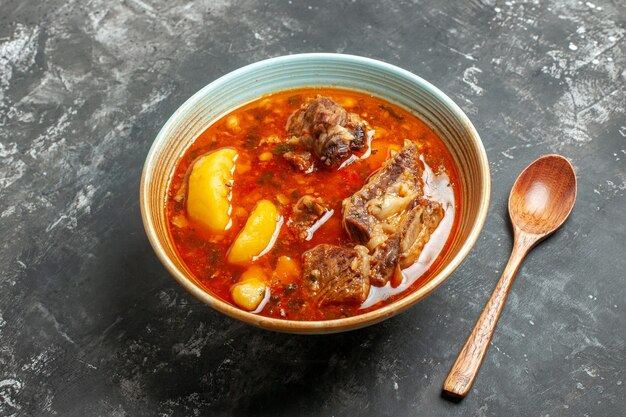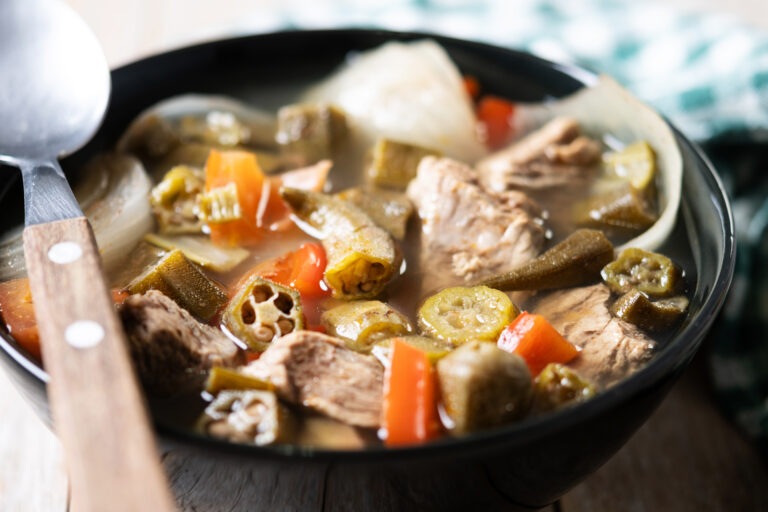Table of Contents

Introduction
Soup bones are a cornerstone of culinary traditions around the world, providing depth and flavor to broths and stews that powdered bouillons and broth cubes can’t match. This post delves into the art and science of using soup bones, exploring everything from their selection and preparation to their cooking and the health benefits they offer. Whether you’re a seasoned chef or a home cook looking to elevate your dishes, understanding how to utilize soup bones effectively can transform your cooking.
The use of soup bones is deeply embedded in culinary history, reflecting a universal ethos of frugality and resourcefulness. In kitchens where nothing was wasted, bones were simmered to extract every last ounce of flavor and nutrition. Today, this practice is not only a nod to culinary tradition but also a standout trend in the world of gastronomy, where the rich, slow-cooked broths provide a base for countless modern recipes and comfort foods.
Additionally, this exploration into the uses of soup bones will uncover the layers of complexity they can add to your meals. By incorporating these techniques into your kitchen repertoire, you can enhance flavors in a way that pre-packaged products cannot achieve, enriching everything from simple soups to elaborate sauces with the unmistakable richness that only comes from carefully prepared bone broth.
Stay tuned as we break down the steps to mastering the use of soup bones, ensuring that your home-cooked meals not only taste better but are also packed with nutritional benefits. This guide will equip you with the knowledge to transform ordinary ingredients into extraordinary culinary creations that resonate with flavors steeped in tradition and enhanced by science.

Selecting the Best Soup Bones
Different Types of Bones
Soup bones can come from a variety of animals, but the most commonly used are beef, chicken, and pork. Each type offers a different flavor profile and nutrient content:
- Beef bones are robust and rich, ideal for hearty beef broths.
- Chicken bones, including necks and backs, make a lighter, more versatile broth perfect for many dishes.
- Pork bones often have a sweeter taste and yield a delicious base for East Asian soups and ramen.
What to Look for When Buying
When purchasing soup bones, look for bones with a bit of meat still attached; these add more flavor to your broth. Marrow bones, with their rich fat content, are especially prized for the depth they can add.
Sourcing Quality Bones
To get the best quality, source your bones from a reputable butcher or local farmers who raise grass-fed or organic animals. These bones are likely to produce a cleaner and more nutritious broth.
Preparing Soup Bones for Cooking
Cleaning and Prepping
Before using the bones, it’s essential to clean them thoroughly. Rinse the bones under cold water to remove any debris or remaining blood.
Roasting for Enhanced Flavor
For a richer, more developed flavor, roast the bones at 400°F (200°C) for about 30 minutes until golden brown. Roasting helps caramelize the remaining meat and fat, adding complexity to the broth.
Boiling Techniques
After roasting, place the bones in a large stockpot, cover with cold water, and slowly bring to a boil. Skimming off the scum and fat that rise to the surface during the first few minutes of boiling ensures a clearer broth.
Crafting the Perfect Bone Broth
Step-by-Step Guide
- Simmering: Once the broth has reached a boil, reduce the heat to a gentle simmer. Simmer beef bones for up to 24 hours; chicken bones need less time, around 12 hours.
- Adding Vegetables: Enhance your broth by adding onions, carrots, and celery during the last few hours of simmering.
- Straining: Use a fine-mesh sieve to strain the broth, discarding the solids.
Importance of Simmering
The slow simmering process allows the full extraction of collagen, marrow, and other nutrients from the bones, which is crucial for a rich and healthful broth.
Achieving Clear, Flavorful Broth
Maintaining a low simmer and not overcrowding the pot are key to achieving a clear broth. A gentle simmer prevents the broth from becoming cloudy due to excessive agitation.
Health Benefits of Bone Broth
Nutritional Components
Bone broth is rich in minerals like calcium, magnesium, phosphorus, and other trace minerals that the body can easily absorb. It’s also high in collagen and gelatin, which support joint health and skin elasticity.
Digestion and Joint Health
The gelatin found in bone broth helps maintain the integrity of the gut lining and supports healthy digestion. Additionally, the glucosamine in bone broth can help support joint health.
Source of Essential Minerals
Regular consumption of bone broth can be a simple way to enhance your mineral intake, supporting overall health and well-being.
Creative Recipes Using Soup Bones
Classic Recipes
Utilizing your homemade broth as the base for classic recipes like beef stew, chicken noodle soup, or even pho not only enhances the flavor but also imbues these dishes with a rich, homemade quality that can’t be replicated with store-bought products. The depth of flavor in the broth can transform a simple meal into a gourmet experience, providing a comforting warmth and nourishment.
- Beef Stew: Let the beef simmer slowly in the bone broth to tenderize and absorb the flavors.
- Chicken Noodle Soup: Use the broth as a base and add fresh vegetables and noodles for a quick, hearty meal.
- Pho: Infuse your broth with spices like star anise, cardamom, and cinnamon to create an authentic Vietnamese favorite.
Innovative Ways to Incorporate
Bone broth’s versatility extends beyond soups and stews. Its rich flavor and nutritional content make it an excellent liquid for cooking grains, and it can also serve as a base for more complex sauces and gravies:
- Risottos: Replace the usual stock with bone broth in your risotto to add a new layer of flavor.
- Gravies: Use the gelatin-rich broth to thicken and enrich gravies, enhancing the taste and texture.
- Cooking Grains: Cook rice, quinoa, or barley in bone broth instead of water to infuse them with minerals and a subtle savoriness.
Storing and Preserving Broth
Bone broth can be stored in the refrigerator for up to 5 days or frozen in small batches for up to 6 months, making it a versatile and nutritious option for quick meals. To maximize convenience, use ice cube trays to freeze the broth in small portions. These cubes are ideal for quick uses, such as deglazing a pan, enriching a sauce, or sautéing vegetables.
Additional Storage Tips:
- Labeling: Always label your containers with the date and type of broth before storing to keep track of freshness and variety.
- Vacuum Sealing: For longer storage, consider vacuum sealing the broth in appropriate portions. This method can extend the shelf life in the freezer and helps prevent freezer burn.
- Refrigeration in Mason Jars: If you plan to use the broth within a few days, storing it in glass mason jars in the refrigerator is a practical option. Be sure to leave some space at the top of the jars as the broth expands when it freezes, to prevent the jars from breaking.
- Boiling Before Use: After thawing, bring the broth to a boil for 1-2 minutes before using. This helps ensure its safety and revitalizes the flavor, especially if it has been stored for several months.
By following these storage and preservation tips, you can ensure that your homemade bone broth retains its nutritional value and flavor, ready to enhance any dish at a moment’s notice.
Additional Tips for Using Bone Broth
- Seasoning Adjustments: Because homemade broth can vary in flavor intensity, adjust the seasoning of your dishes gradually. Start with less salt, and taste as you go.
- Nutritional Boost: For an extra health boost, stir in a spoonful of turmeric or ginger into the broth during the last few minutes of cooking. These spices add anti-inflammatory properties and a burst of flavor.
- Creative Blends: Consider blending different types of bones in one batch of broth to create a unique flavor profile. For example, combining chicken and beef bones can offer a balanced depth suitable for various dishes.
By incorporating these techniques and ideas, you can elevate your culinary creations and make the most out of every batch of homemade soup bones broth. Whether you’re looking for comfort food or gourmet delights, the natural richness of bone broth can be the secret ingredient that brings your dishes to life.
Conclusion
Utilizing soup bones in your cooking not only enriches the flavor of your dishes but also provides significant health benefits. Whether you’re making a simple chicken broth or an elaborate beef stew, the techniques discussed here will help you craft the perfect soup. Experimenting with different types of bones and cooking methods can lead to delightful discoveries in the kitchen. The richness and depth that bone broths bring to recipes are unmatched, offering layers of flavor that enhance everything from soups and stews to grains and vegetables.
Moreover, embracing the tradition of using soup bones connects us to a history of resourceful cooking, promoting sustainability through the use of entire animal parts that might otherwise be discarded. This approach not only maximizes the value of our food but also aligns with ethical cooking practices by honoring the life and contributions of the animals.
I encourage you to share your culinary adventures and discoveries in the comments below. What are your favorite recipes using bone broth? Do you have tips for creating the most flavorful and nutritious broths? Your insights can help foster a community of like-minded cooks who value the art of traditional cooking methods. Let’s continue learning from each other and celebrate the rich, wholesome goodness that comes from a pot of lovingly prepared bone broth.





